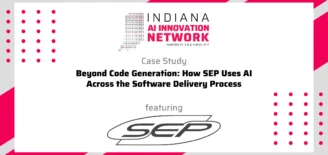Ag tech innovator helping farmers grow more, better crops
 The Kauffman Foundation and Donald Danforth Plant Science Center published a paper last year stating that global food demand that is expected to increase 70 percent by 2050. Food prices are expected to rise as much as 100 percent during that time.
The Kauffman Foundation and Donald Danforth Plant Science Center published a paper last year stating that global food demand that is expected to increase 70 percent by 2050. Food prices are expected to rise as much as 100 percent during that time.
Even though global food production has tripled over the past 50 years, the paper points out that it won’t be enough unless entrepreneurs in the ag tech space step up with innovations to increase productivity.
Purdue University scientist Dr. Johnny Park and the fast-growing startup he founded — Spensa Technologies — are answering that call for ag tech innovations.
Despite the fact that farmers spend $4.5 billion annually on pesticides, $20 billion worth of crops are still damaged in the U.S. alone every year due to insect pests.
Spensa’s precision pest management hardware and software make it easier and cheaper to use pesticides more effectively, which ultimately results in better crops with a lot less damage. The biggest difference between what Spensa offers and common pest management procedures is the use of technology to automate the process and reduce error.
Spensa’s Z-Traps catch insect pests and provide automatic, real-time trap data through Spensa’s MyTraps pest population monitoring software using laptops, tablets and smartphones. The systems allows farmers to catch problems early, use less pesticides, and save more crops.
In the simplest terms, what does Spensa Technologies do?
Spensa designs, develops and delivers novel precision agriculture hardware and software technologies that reduce reliance on manual labor, foster eco-friendly farming, and enhance crop production efficiency. Our system of Z-Trap hardware and MyTraps software automates the insect monitoring process providing real time accurate data. We also recently launched OpenScout mobile scouting software.
OpenScout is a mobile app that easily records notes and photos while a farmer or farm hand walks the fields. Observations are automatically geo-tagged and time-stamped for easy retrieval and visualization. It’s an up grade in the pest the management process that’s equivalent to the difference between using one of those printed maps from a gas station or using Google Maps or Apple Maps on your favorite device.

What are the three most important features of Spensa?
- Wireless network communication with low-power embedded system for season long power
- Bio-impedance sensor and pattern recognition algorithm to detect and identify insects
- Elegantly simple software to provide decision information.
What pain points are most prevalent for your customers?
Over $20B of crop damage still occurs in the US due to insect pests despite the fact that $4.5B of insecticides are used. Pesticide decisions are largely made using a labor intensive and sometimes error prone manual process of monitoring insect traps. Our automated systems save the grower time and money and reduce unnecessary pesticide use.
Can you outline the experience of developing Spensa?
Our founder Dr. Johnny Park was part of a USDA grant to Purdue University to research automation in specialty crop agriculture. Once he saw the many opportunities to use sophisticated robotics and computer vision to improve productivity in agriculture he formed the company with it’s first focused invention being the Z-Trap automated insect monitoring system, and the company has grown from there into both hardware and software innovations.
Tell us about the team who built Spensa. How did you overcome obstacles?
We have a team of software and hardware engineers who design and develop the products. Our team has deep expertise in robotics, computer vision, data analysis and software user interfaces. Once we had our product developed we spent three years in real field situations testing the product and looking for user interface improvements. We overcame many of our early obstacles just by listening carefully to the early adopters of our technology and making meaningful modifications.
How has Spensa funded its exceptional growth?
Our initial funding came from friends and family and grants from USDA and NSF. We recently completed a $1.3M seed round with the following investors, many of whom have Indiana connections:
- Elevate Ventures
- Foundry Investments
- mTerra Ventures
- Zionsville Precision Ag Ventures LLC
- John T. Smith and other private investors
Describe your growth trajectory.
We have seen strong growth for both our software and hardware solutions. We particularly see rapid adoption of our software solutions which provide both data and decision making insights for commercial agriculture producers.
What makes Spensa different from other pest control players?
We are not simply just a hardware or just a software company. We have the skills and experience to build data collection hardware and sensors and integrate them with highly user-friendly software that delivers real, actionable precision ag insights.
What are your biggest lessons learned through creating and launching Spensa?
Nothing ever happens as quickly as you plan for it to. You often underestimate the dollars and time required to get to a desired outcome.




